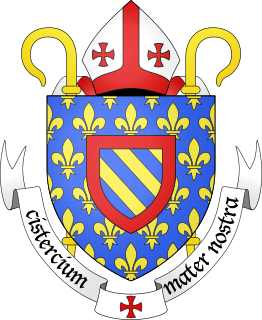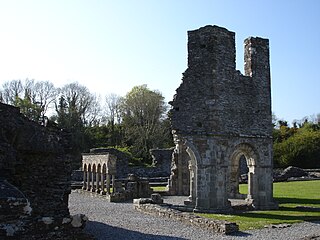Contents
| |||||
| Centuries: | |||||
|---|---|---|---|---|---|
| Decades: | |||||
| See also: | Other events of 1142 List of years in Ireland | ||||
Events from the year 1142 in Ireland.
| |||||
| Centuries: | |||||
|---|---|---|---|---|---|
| Decades: | |||||
| See also: | Other events of 1142 List of years in Ireland | ||||
Events from the year 1142 in Ireland.

The Cistercians, officially the Order of Cistercians, are a Catholic religious order of monks and nuns that branched off from the Benedictines and follow the Rule of Saint Benedict. They are also known as Bernardines, after the highly influential St. Bernard of Clairvaux ; or as White Monks, in reference to the colour of the "cuccula" or white choir robe worn by the Cistercians over their habits, as opposed to the black cuccula worn by Benedictine monks.

Ireland is an island in the North Atlantic. It is separated from Great Britain to its east by the North Channel, the Irish Sea, and St George's Channel. Ireland is the second-largest island of the British Isles, the third-largest in Europe, and the twentieth-largest on Earth.

Mellifont Abbey, was a Cistercian abbey located close to Drogheda in County Louth, Ireland. It was the first abbey of the order to be built in Ireland. In 1152, it hosted the Synod of Kells-Mellifont. After its dissolution in 1539 the abbey became a private manor house. This saw the signing of the Treaty of Mellifont in 1603 and served as William of Orange's headquarters in 1690 during the Battle of the Boyne.
Conchobar Ua Briain was a mid-twelfth-century ruler of the kingdoms of Munster and Dublin.
Diarmait Mac Murchada, anglicised as Dermot MacMurrough, Dermod MacMurrough, Dermot MacMorrogh or Dermot MacMorrow, was a King of Leinster in Ireland. In 1167, he was deprived of his kingdom by the High King of Ireland – Ruaidri Ua Conchobair. The grounds for the dispossession were that Mac Murchada had, in 1152, abducted Derbforgaill, the wife of the King of Breifne, Tiernan O'Rourke. To recover his kingdom, Mac Murchada solicited help from the King of England Henry II of England. His issue unresolved, he gained the military support of the Earl Richard de Clare, the 2nd Earl of Pembroke, who was in opposition to Henry II due to his support for Stephen, King of England against Henry's mother in The Anarchy. In exchange for his aid, Strongbow was married to Mac Murchada's daughter Aoife and promised succession to the Kingship of Leinster. Henry II then mounted a larger second invasion in 1171 to ensure his control over Strongbow, resulting in the Norman Lordship of Ireland. Mac Murchada was later known as Diarmait na nGall.

Domhnall Ua Lochlainn, also known as Domhnall Mac Lochlainn, claimed to be High King of Ireland.
Muircheartach Ua Briain, son of Toirdelbach Ua Briain and great-grandson of Brian Bóruma, was King of Munster and later self-declared High King of Ireland.
Events from the year 1119 in Ireland.
Events from the year 1101 in Ireland.
Events from the year 1156 in Ireland.
Events from the year 1111 in Ireland.
Events from the year 1126 in Ireland.
Events from the year 1134 in Ireland.
Events from the year 1148 in Ireland.
Events from the year 1152 in Ireland.
Events from the year 1166 in Ireland.
Events from the year 1177 in Ireland.
Events from the year 1224 in Ireland.
Events from the 10th century in Ireland.
Events from the 11th century in Ireland.

Abbeyknockmoy is a village and parish in County Galway, Republic of Ireland. It is best known for the nearby ruins of the 12th century Cistercian abbey, established with the Kings of Connacht as its benefactors. The abbey was the burial site of King Cathal Crobhdearg Ua Conchobair and contains fine examples of medieval wall paintings and sculpture. It was formerly part of the kingdom of the Soghain of Connacht.
Events from the year 1216 in Ireland.
Events from the year 1139 in Ireland.
Ímar ua Ímair was a Norse or Norse-Gaelic King of Dublin. He was a grandson of Ímar and a member of the Uí Ímair.